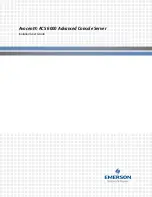
Page 144
Configuring TCP/IP Routing
90030500B
Types Of Routing Available
You can configure PortServer II to act as an IP packet router (see Chapter 1 for a typ-
ical system configuration, in which branch office users are connected to an Internet
service provider).
PortServer II supports two types of routing, Passive and Active. With passive routing,
it takes packets in from hosts and routers connected to it, and decides where to for-
ward them. During active routing, it performs passive routing, but also informs other
systems about destinations they can reach by forwarding packets to PortServer II.
PortServer II uses three sources of information to create a Route Table, which decides
where packets are forwarded. You can view the contents of the Route Table by enter-
ing the
set route
command with no options.
The first source is the configuration information you enter for each interface. The
address of the Ethernet interface is used with any subnet mask to determine which
destination addresses are reachable through that interface. For example, if the Ethernet
interface has the address 192.83.159.15 and a subnet mask set to 255.255.255.0, any
IP address from 192.83.159.0 through 192.83.159.255 can be reached through the
Ethernet interface. For WAN connections, the IP address of the remote system and
any subnet mask determine that addresses can be reached through the WAN connec-
tion. For example, if a WAN connection has a remote IP address of 192.83.159.17 and
a subnet mask of 255.255.255.255, PortServer II assumes it can only reach IP address
192.83.159.17 through the WAN interface. However, if the subnet mask is
255.255.255.240, PortServer II can reach IP addresses 192.83.159.16 through
192.83.159.31 through the WAN interface.
The second source of routing information is static routes. PortServer II can be manu-
ally configured with static routes using the set route command. For example, if the
set route command is entered with net=192.83.160.1, mask=255.255.255.255, and
gateway=192.83.159.17, PortServer II will route packets destined for IP addresses
192.83.160.1 through 192.83.159.17. PortServer II allows dependency routes, in
which routes associated with the WAN may not be permanently established. While
the WAN connection is present, the route is considered active and is used to route
packets. When the WAN goes inactive, the route is generally ignored.
Note:
For routing purposes, a dial-out or bi-directional WAN connection that is set
to connect on network traffic by a bringup filter is considered always active.
The third source of routing information is routes that other routers have told
PortServer II about, using RIP (Routing Information Protocol).
Содержание PortServer II
Страница 1: ...8VHU V XLGH PortServer II QWHOOLJHQW 1HWZRUN RPPXQLFDWLRQV DQG 7HUPLQDO 6HUYHU ...
Страница 2: ......
Страница 4: ...90030500B Page ii ...
Страница 20: ...Page xviii About this User s Guide 90030500B ...
Страница 74: ...Page 54 Installation 90030500B ...
Страница 106: ...Page 86 Configuring Terminals 90030500B ...
Страница 144: ...Page 124 Configuring WAN Connections 90030500B ...
Страница 168: ...Page 148 Configuring TCP IP Routing 90030500B ...
Страница 180: ...Page 160 Configuring SNMP 90030500B ...
Страница 206: ...Page 186 Remote Configuration 90030500B ...
Страница 264: ...Page 244 Digi Support Services 90030500B ...
Страница 270: ...Page 250 Glossary 90030500B ...















































